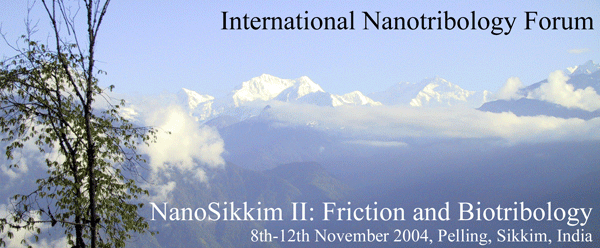Nanosikkim II will be held in Pelling under the shadow of the famous Buddist monastery of Pemayangtse. Located in the North Eastern part of India, Sikkim is easily accesible by air from Kolkatta (Calcutta) and New Delhi.
The panoramic view of the Mt. Kanchenjunga and its lesser peaks from the Norbugang Resort, will provide a fitting backdrop for the meeting.
Lose yourself in the verdant wilds of Sikkim by trekking, mountaineering and whatever else your heart wishes to do. Treat your taste buds to exotic Sikkimese dishes, inhale fresh, unpolluted Sikkimese air, and watch the intriguing lifestyle and charming ethinicity of Sikkim unfold in front of your eyes.
Pelling
Pelling at an altitude of 2,085 m, presents breathtaking views of the beautiful Singalila range of the Himalayas. Pelling is on the state highway connecting Gangtok and Yoksum and rests at the foot of snow-capped Mt.Kanchenjunga (8585m). The important Pemayangtse monastery is a few kilometers from Pelling and is situated on a hilltop (2130 m) which is covered by moist temperate Oak forests decorated with moss and lichens.
Besides heritage sites and monasteries, west Sikkim is extremely rich in biodiversity. It has a mind-boggling array of flora and fauna. The hills and valleys abound with numerous orchid, primula, rhododendrons, marigolds, magnolia and cherry to name a few. The exotic aroma of the large cardamom waft along mist-laden hillsides, home of the musk deer and the red panda. Innumerable butterflies flit among the verdant woods lending colour to the rich green hue. Sikkim has more that 500 species of butterflies. Perhaps the pride of the flora of West Sikkim are its dense rhododendron forests varying from the towering giants of the lower regions to the dwarf varieties found above the snow-line. The delicate flowers too are as variegated, from the blood-red thomsonii to pale lilac to brilliant white.
Sikkim
Small but beautiful, Sikkim situated in the Eastern Himalayas spread below the world's third highest mountain Kanchenjunga (8585m) revered by the Sikkimese as their protective deity. Sikkim is separated by the Singalila range from Nepal in the west, Chola range from Tibet in the northeast and Bhutan in the southeast.
Rangit and Rangpo
rivers form the borders with the Indian state of West Bengal in the south.
Though measuring just 65 Km by 115 Km (nearly the size of Switzerland) it ranges from sweltering deep valleys a mere three hundred meters above sea level to lofty snow peaks such as Kanchenjunga. On its west side is the massive 31 Km long Zemu glacier. Various explorers and mountaineers have claimed to have seen the Yeti or its foot prints in the vicinity of the mountain and its glacier: "The abominable snowman" has its place in folklore.
Climate
The climate of the state has been roughly divided into the tropical, temperature and alphine zones. For most of the period in a a year, the climate is cold and humid as rainfall occurs in each month. The area experiences a heavy rainfall due to its proximity to the Bay of Bengal. The rainfall in north district is comparatively less than of the other districts. The general trend of decrease in temperature with increase in altitude holds good everywhere. Pre-monsoon rain occurs in April-May and monsoon (south-west) operates normally from the month of May and continues up to early October.
| Temperature : |
Summer |
Max: 21C |
Min: 13C |
| |
Winter | Max: 13C |
Min: 0C |
Rainfall :
Mainly from May to early October due to South East Monsoon (325 cm per annum )
Clothings :
Heavy Woollens are recommended for the Winter.
For more information
click here
How to get there:
Air
The nearest airport is Bagdogara (New Jalpaiguri), West Bengal, India. From Bagdogara it takes about 6 hrs travel through winding roads on the ghat sections of the West Sikkim along the river Rangit - the breathtaking views compensate the travel fatigue.
Train
The nearest railhead is at New Jalpaiguri, approximately 147 Km from Pelling. New Jalpaiguri is connected by Indian Railways to various major cities of India, including New Delhi, Mumbai, Kolkatta and Chennai.
Air/Train timings
